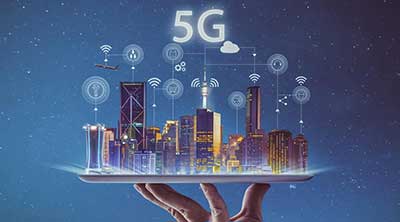Date: 30/01/2023
Relevance: GS-3: Science and Technology- developments and their applications and effects in everyday life.
Key Phrases: 5G, IoT, Automation, Virtual Reality, Urban Environments, Innovation, 5G Islands, Infrastructure, , 3D Simulation, Manufacturing, Healthcare, Automotive, Welfare Service-Delivery.
Context:
- More than 25% of India’s population is being covered by 5G as of January 25, reported the research firm Techarc. As per the report, this 25.2% of the population lives across 189 locations within the country.
- Based on the dashboard data, 25.2% of India’s population is covered with live 5G networks, making the technology available to 1 in every 4 cities of the country.
Key Highlights:
- 5G technology is expected to drive significant advancements and economic growth, but understanding its full potential requires knowledge of related technologies such as IoT, automation, virtual reality, and Web3.
- The users increasingly expect better communication, faster data access and in greater volumes. 5G promises to deliver all that and more.
- However, it's worth considering how the implementation of 5G technology will impact our spaces and our understanding of what it means to be "urban" in the years leading up to its full realization.
Future of Urbanisation:
- Imagining the impact of 5G on the design and planning of future urban environments in India leads to the idea of small, wealthy islands created by technological innovation driven by 5G.
- These islands can be imagined as compact, connected, and well-equipped urban areas focused on one or more economic or social activities driven by 5G technology.
- The future of urbanization in India is likely to unfold through the
growth of these small, wealthy islands driven by 5G technology.
- This prediction is based on the understanding that 5G will transform many economic activities, change the way people interact professionally; require localization of certain tasks and the development of specific infrastructure.
- All of these changes would lead to a new form of urbanization in India.
The Technology:
- The excitement around 5G is not just due to the improved speed it
offers compared to previous generations of mobile networks, but also
because of the significant increase in mobile users in recent years.
- These users demand better communication, faster data access and larger amounts of data. 5G is expected to deliver on these demands, with its high speed and minimal delay.
- This will lead to widespread use of machine-to-machine communication and IoT (Internet of Things), which will enable connected devices to share real-time data.
- The large amounts of data generated by these devices will require
real-time processing, driving the adoption of edge computing.
- This means that data will need to be processed as close to the source as possible. This may require the creation of small or micro data centers near the location where the data is generated, such as near 5G towers.
- The significant reduction in communication lag could make virtual reality co-working more feasible and smooth.
- 3D simulations and virtual environments enabled by 5G may allow
employees to connect and collaborate in a way that mimics the informal
interactions.
- This could help alleviate the "Zoom fatigue" caused by the current reliance on video conferencing. Additionally, 5G's ability to enable remote work could make geographical location increasingly insignificant.
- 5G is not only meant for the consumer market, but it is also designed to
support a variety of industries such as agriculture, manufacturing,
healthcare, automotive and welfare service delivery, among others.
- This means that 5G's success cannot only depend on consumer adoption, but it also needs to monetize its use in businesses to make it economically viable.
- Time-critical communication provided by 5G may revolutionize sectors
like manufacturing.
- The deployment of captive 5G network in Mahindra’s auto manufacturing facility in Chakan last month is a case-in-point.
- This property will largely be facilitated by utilising high frequency bandwidth that can carry large amounts of data per unit time.
Way Forward:
- The various aspects of 5G discussed above offer intriguing
perspectives on the future of urbanization.
- Be it localised micro-data centres or 5G-networked industries or the antenna infrastructure, it will require the establishment of hubs replete with 5G-propelled economic units, network infrastructure and social provisions for the employees and their families, or, what we call the ‘5G islands’.
- These islands could take the form of townships specifically suited to
employees in remote-working sectors or be centred on automatic or
semi-automatic industrial clusters; opportunities are endless.
- Parts of existing cities may be overlaid with these islands or new islands may be planned closer to bigger cities much like the existing satellite cities.
- These townships may even come up in the underutilised peri-urban areas.
Conclusion:
- The utilization of 5G-specific applications that utilize higher
frequency bands will create vast opportunities for growth in the country,
shaping a new form of urbanization.
- This new form of urbanization can also be sustainable and resilient if proper planning methods are implemented.
- Compact urbanization reduces land usage per inhabitant and per job, which can be combined with a diverse range of land usage and untouched natural areas in between.
- It is important for urban planners and policymakers to take into account the effect of 5G on urbanization as it develops, allowing for well-planned, efficient, sustainable and resilient urban systems in the future.
Source: Business Line
Mains Question:
Q. 5G has the potential to reorder urban spaces, and alter the production and communication experience. Discuss (150 words)







